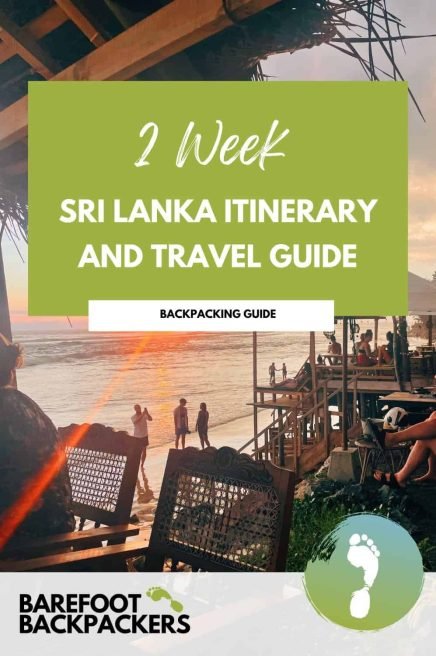If you are looking for a Sri Lanka itinerary that offers the best of the country in two weeks, then we have got you covered. Sri Lanka is an incredible place for a two-week trip. It has beaches and surf in the south, tea country in the central highlands, and ancient sites in the Cultural Triangle. This plan was created around the January weather. The south and west coast are at their best between December and April. While the East Coast is best between May and September. We found that two weeks gives you enough time to travel the island without feeling rushed. With beach days, mountain escapes, and cultural days exploring rock temples and ruins. There’s room to rest, catch a surf, or take a tea tour without feeling like you’re racing around.
From local food markets, tuk-tuk journeys, a train ride through tea plantations, Adam’s Peak Pilgrimage, hikes, and time in quiet towns. Our route goes like this: Weligama → Ella → Nuwara Eliya → Kandy → Sigiriya/Dambulla → Colombo.
Read more: 8 Best Retreats in Sri Lanka for Wellness & Nature
Below you’ll find day breakdowns, practical costs in USD, transport tips, and safety and women-travel advice. If you prefer more or less moving about, tweak the nights. Add an extra night in Ella for hiking or swap a night in Sigiriya for more time in Kandy. Sri Lanka is forgiving of slow travel. The trains and buses are frequent enough and cheap, but plan long transfer days realistically because roads in some parts are winding and slower than you expect.
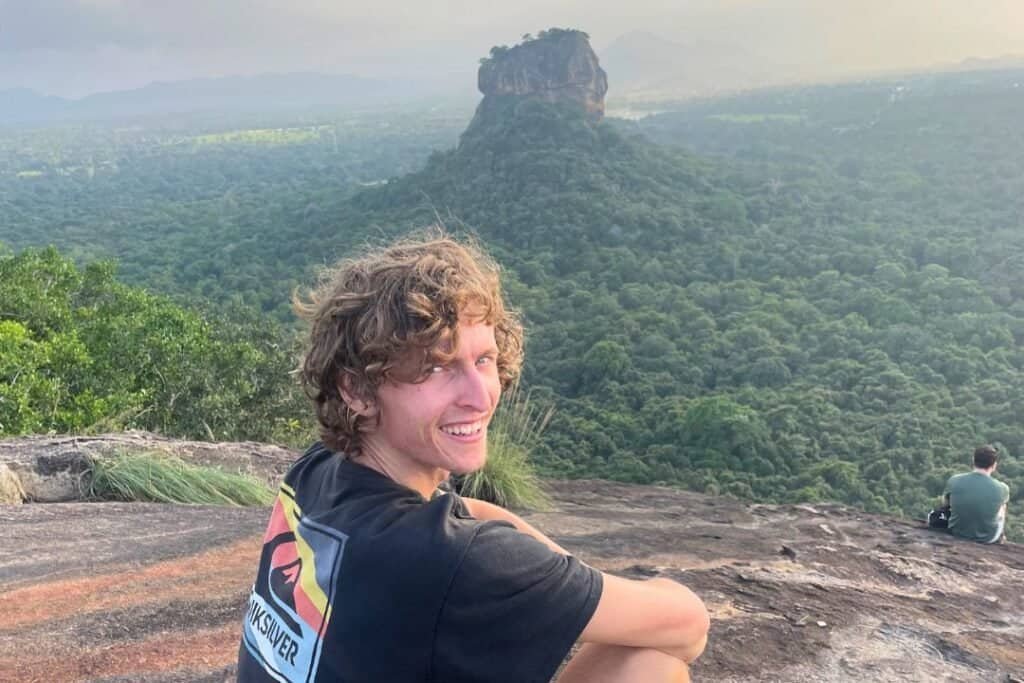
This blog is supported by the community. We may earn a small commission if you choose to purchase through our links, which allows us to keep creating content. As an Amazon Associate, we earn from qualifying purchases. Learn more.
Sri Lanka Itinerary Breakdown: 2 Weeks
For shorter trips, this two-week loop gives you beaches, mountains, and the cultural heart of Sri Lanka without feeling rushed.
- Start in Colombo (1–2 nights) — spend a day or two recovering from your flight, exploring local markets, or just head straight to the beach like we did
- Head to Weligama (4 nights) — base yourself for surfing, yoga, and day trips to Mirissa or Galle.
- Travel inland to Ella (2 nights) — Hike Little Adam’s Peak or visit the Nine Arch Bridge.
- Continue to Nuwara Eliya (2 nights) — take a tuk-tuk tour through tea plantations and cool mountain air, or take a day trip to Adam’s Peak.
- Visit Kandy (1 night)— explore the Temple of the Tooth and the lake, and catch a local cultural dance show.
- Go a little north to Sigiriya or Dambulla (4 nights) — climb Sigiriya Rock Fortress, visit Dambulla Cave Temple, and take a safari in Hurulu or Minneriya National Park.
- Return to Colombo (1–2 nights)— spend your last night in the capital
- If you’re extending your trip, you can loop east toward Arugam Bay (May–September surf season) or head north to Jaffna for less-touristed Tamil culture and history.
Sri Lanka: Two-Week Itinerary
Weligama area — 4 nights
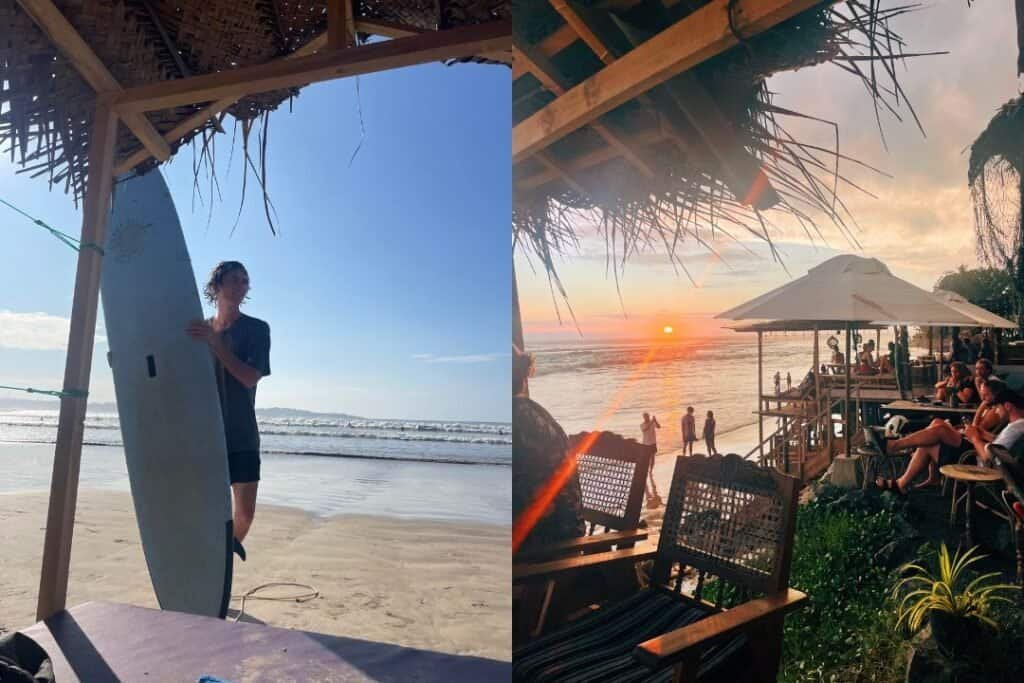
Weligama is a lively but approachable surf town on the south coast. It’s a great place to reset after a long flight: mornings can be for slow coffee and conversation in beach cafés, afternoons for surf lessons, and evenings for seafood and a sunset walk on the wide sand. The surf here is beginner-friendly, with mellow reefs and plenty of instructors, so it’s ideal for first-time surfers who want to stand up quickly. You’ll also find yoga classes, an ice bath, and a few wellness studios for post-surf recovery. We enjoyed the ice baths and then warming up in the sun.
Accommodation, transport, and food in Weligama
There are a few options for where you can stay around Weligama. We stayed in Ahangama, a smaller beach town, because we had a scooter, but if you are getting around on foot, Weligama would be better. As getting around is easiest by scooter or tuk-tuk, you can rent scooters for $6–$12 per day, depending on the model and whether fuel is included. Public buses stop here but are often crowded and slower; taxis scale quickly if you lean on them for multiple day trips. If you plan on a few-day excursions (e.g., Mirissa, Galle Fort, or the stilt fishermen viewpoint), factor in trips of 20–60 minutes each way and modest transfer fees. Weligama also has great nightlife, so if that is something you are interested in, you will have a good time here.
Let’s talk about the delicious food. The food is beach-friendly: rice and curry, fresh fish, and cafés offering western breakfast options. Expect a plate of good local food for $2–$5 at simple spots; nicer cafés and seafood restaurants will be $8–$15. There are also spots that lean into wellness food — cold-pressed juices, smoothie bowls, and Ayurvedic snacks — for slightly higher prices, and they’re great if you want to ease into travel gently.
Mirissa, Galle, and Unawatuna
Weligama can be a hub for short trips: day boat trips for whale watching from Mirissa (seasonal; about $30–$60), visits to the colonial town of Galle (fort, shops, and good bakeries), and evening markets. If you want quieter beaches, head east toward Unawatuna in early mornings or choose a quieter bay south of Mirissa. Nightlife is modest; there are bars and live music, but not much clubbing, which is perfect if you want relaxed evenings.
Ella — 2 nights
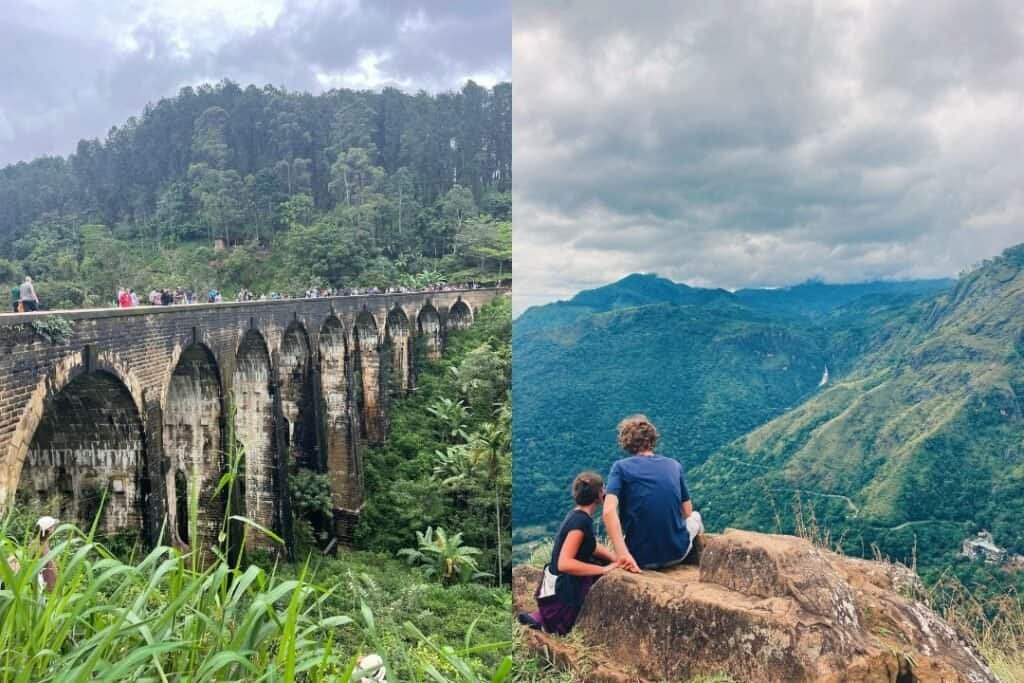
Ella is a hill town that is beautiful but is under development, with lots of new buildings being constructed. The train ride from Ella (see transport section for tips) is one of Sri Lanka’s most famous journeys: lush tea slopes, pocket villages, and dramatic ridgelines slip past your window. Ella itself is small but lively; there are cafés, a cluster of guesthouses, and a handful of trekking options that make it a walker’s delight. Little Adam’s Peak and the Nine Arch Bridge are the most popular short hikes and can be done in half a day each.
We took an Uber with three people to Ella on one leg, and it split to about $55 total. Buses are slower and often require multiple changes, so for opted for an Uber from Weligama to Ella. Accommodation ranges from budget guesthouses ($10–$20) to nicer eco-lodges and treehouses ($40–$80). Homestays here offer good value and local insight — we stayed at a homestay up the hill and enjoyed the view more than the rooms themselves.
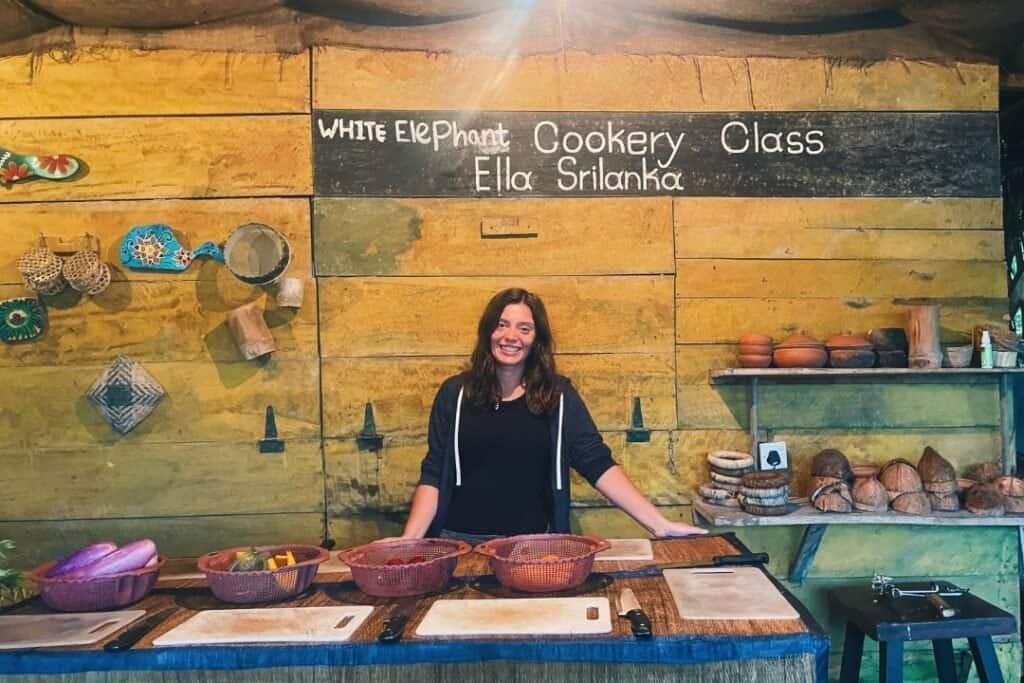
Things to do in Ella
Local tips: book any specialty activities (guided hikes, cooking classes) a day in advance during peak season. Here is a cooking class on Get Your Guide that is well-rated. If you do want the scenic train, buy or line up for tickets early (see transport section). Ella is also a good place to practice slow food — try local kottu, hoppers for breakfast, and small-batch coffee roasted in town.
Days in Ella are for exploring waterfalls and tea trails. Ravana Falls and Ella Rock are full-day options if the weather permits. Note that conditions can change fast — on our visit, a storm shut down some treks, so build buffer time into your schedule. In the evenings, cafés and small restaurants fill with travelers swapping notes and travel plans.
Nuwara Eliya — 2 nights
First travel logistics – the train ride from Ella toward Nuwara Eliya (via Nanu Oya station) is one of the classic Sri Lankan experiences, but it can be busy — arrive early to secure a reserved seat or stand prepared for peak times.
Nuwara Eliya sits high in the tea country and feels cooler, gentler — the reason it’s called “Little England.” Expect tidy colonial architecture and tea tourism. We recommend a tuk-tuk tour around the surrounding plantations and a visit to a tea factory where you can see with your own eyes how black tea gets processed and sample straight from the source.
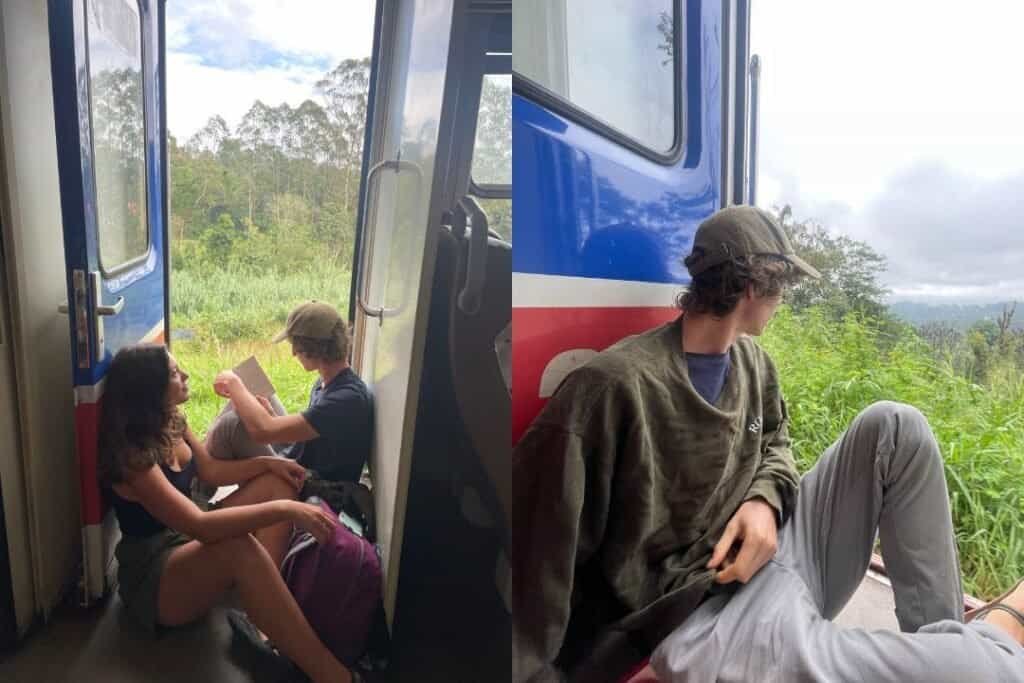
Activities beyond tea include hiking, visiting botanical gardens, and exploring the small market. There’s also a weekend farmers’ market with seasonal produce and homemade preserves that make great travel snacks. The town’s cooler temperature means pack a light jacket — nights can be noticeably chilly, especially compared to the coast. About a 45-minute drive from Nuwara Eliya is the Horton Plains National Park. Here you can do a nice hike to ‘World’s End’, where you have an amazing view.
Food and lodging follow a spectrum: basic guesthouses ($12–$25), midrange hotels ($40–$80), and a few boutique colonial properties if you want comfort and classic gardens. Walk slowly, enjoy the slower rhythm, and use this as a reset day before the cultural triangle. Nuwara Eliya is also a good place to base yourself to do a day trip to Adam’s Peak.
Adam’s Peak
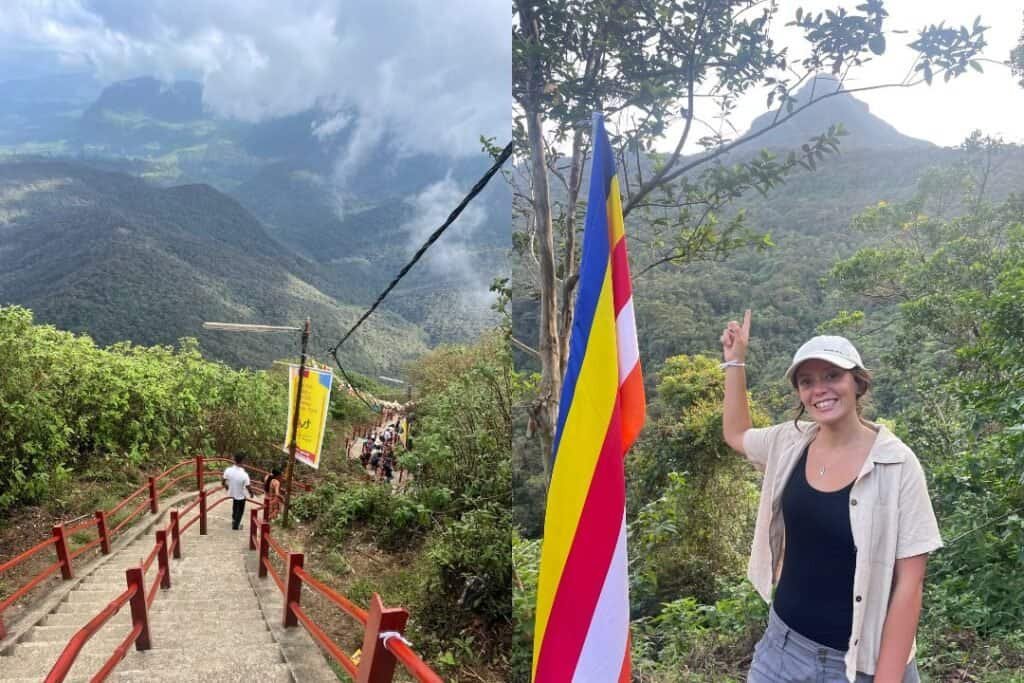
If you plan to visit Adam’s Peak from here, organize transport the day before; it’s a long transfer and requires an early start. We took a taxi to Adam’s Peak, and it took around a couple of hour to get there.
If you love hiking and walking long distances, Adam’s Peak, also known as ‘Sri Pada,’ offers not just beautiful views. It also a deep connection with the heart and soul of Sri Lanka’s hill country. It’s the fifth-tallest peak in the country and rises just above 2000 meters. As well as being the source of three major rivers in Sri Lanka and home to a small elephant population. You can stay in Hatton, the nearest town, or take a day trip from Nuwara Eliya like we did.
A little bit of context: the mountain is a spiritual pilgrimage route that has been around for a thousand years, or more. At its summit is a footprint-shaped indentation, sacred in multiple religions. Muslims and Christians regard it as the footprint of Adam. Whereas Buddhists believe it is the footprint of Lord Buddha. Also, Hindus associate it with Lord Shiva.
Hatton Route
We took the Hatton Route (Nallathanniya Route) as it is the most popular and well-maintained path. It is shorter but steeper than the Ratnapura Route (8-12 hours). The Hatton Route takes about 3-5 hours to climb. For most travelers, the Hatton route is the best choice due to its accessibility and facilities along the way.
A few tips – try hiking earlier in the morning or later in the afternoon. We ended up going midday, and it was so hot. Make sure to bring water, but there are so many places to buy snacks, chai, and even a Mr.Whippy ice cream machine. So don’t worry about overpacking supplies.
Kandy — 1 night
Kandy is the island’s cultural heart and a compact city centered around a beautiful lake. It’s also home to the Temple of the Tooth (Sri Dalada Maligawa), one of Sri Lanka’s most sacred Buddhist site. It’s a highly atmospheric place to visit, especially in the evening when rituals and chants create a calming energy. A short walk from the temple are markets, bakeries, and small lanes perfect for a late afternoon stroll.
We used the train from the Nuwara Eliya region to Kandy — a straightforward trip, but book early or show up with time to spare for ticket queues. Once in Kandy, the city is easy to navigate on foot for the core sights; tuk-tuks are cheap for short hops. Expect quick cultural shows (dance and drumming) in the evenings — they can be touristy but entertaining and a good introduction to local life.
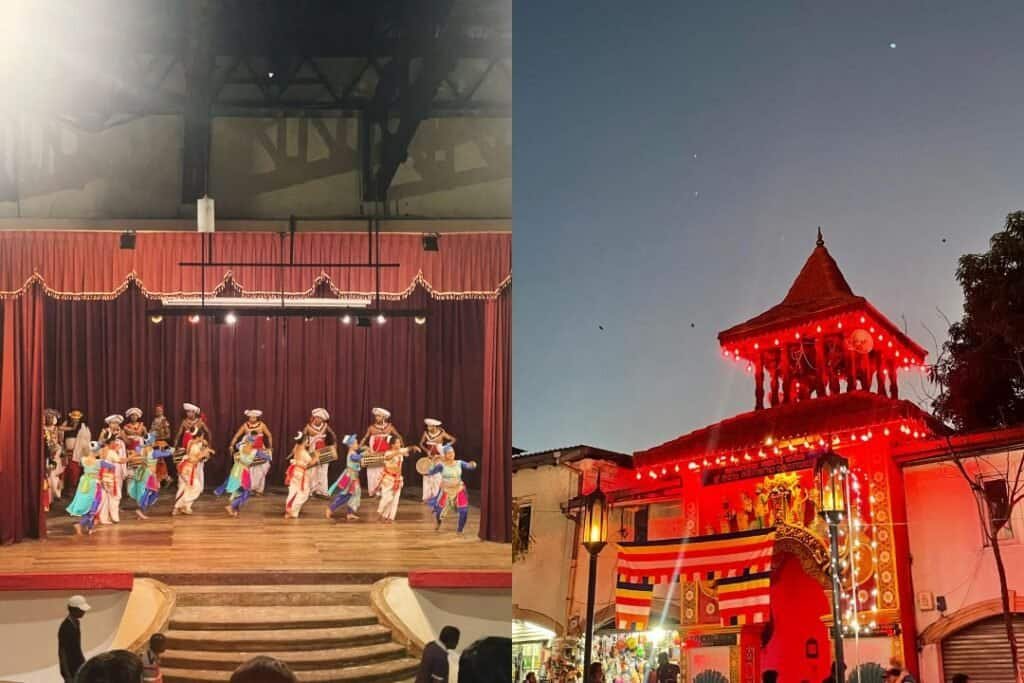
Food options here include Sri Lankan classics and more international choices for when you need familiar comfort food. Accommodation covers everything from hostels and guesthouses ($8–$25) to midrange hotels around $35–$70. Kandy is a solid one-night stop, but you could extend to two nights to explore nearby botanical gardens and tea viewpoints.
Sigiriya / Dambulla and the Cultural Triangle — 4 nights
The Cultural Triangle is the reason many travelers come to Sri Lanka: ancient cities, carved cave temples, and iconic rock citadels. Base yourself in Sigiriya or Dambulla for easy access to the big sights.
Accommodation in this area ranges from budget guesthouses ($10–$20) to comfortable eco-lodges ($40–90). There are a few luxury properties closer to the big sites. The area is easy to combine with short tuk-tuk village tours, guided walks through local farms, and sunset viewpoints.
Dambulla Cave Temple is nearby and offers an atmospheric series of painted caves and Buddha statues. It’s an easy half-day visit and worth combining with a village tuk-tuk tour. We also recommend a trip to Polonnaruwa if you want broader ruins that are quiet and spread out. It’s a great area to hire a bicycle and explore at your own pace. Also, the region is lined with smaller temples, village markets, and opportunities to see rural life.
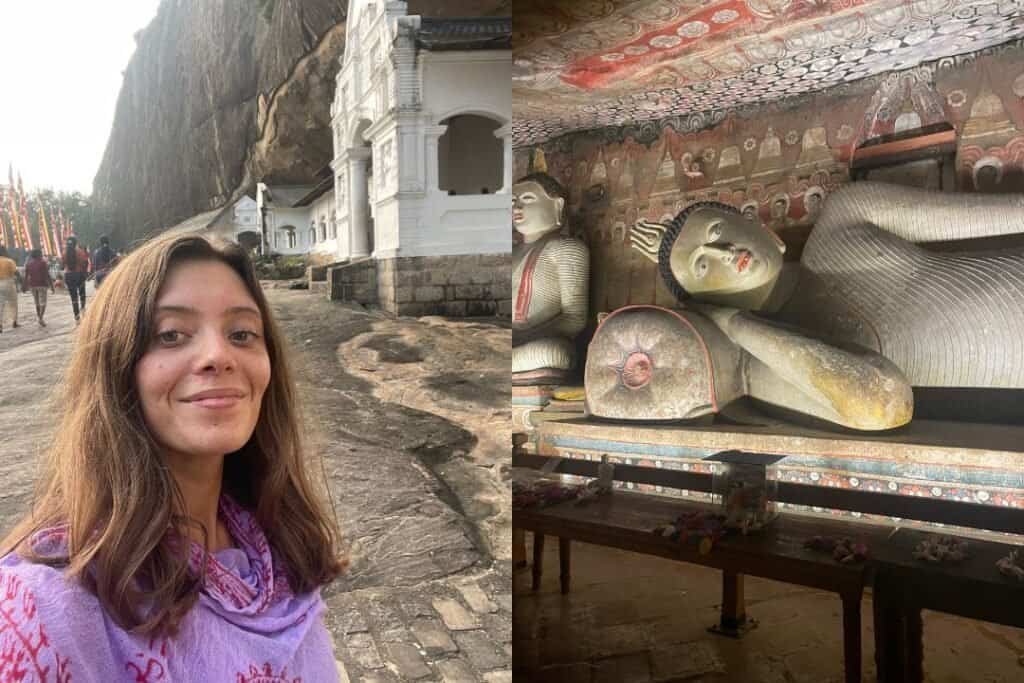
For wildlife, we booked an elephant safari at Minneriya or Hurulu (reservations recommended). They are especially good for the elephant gatherings if you’re there in the right season. Safaris vary in cost — expect about $30–$60 per person, depending on private vs group tour and vehicle type (jeep vs open truck). Local wildlife guides add huge value to spotting and understanding animal behavior.
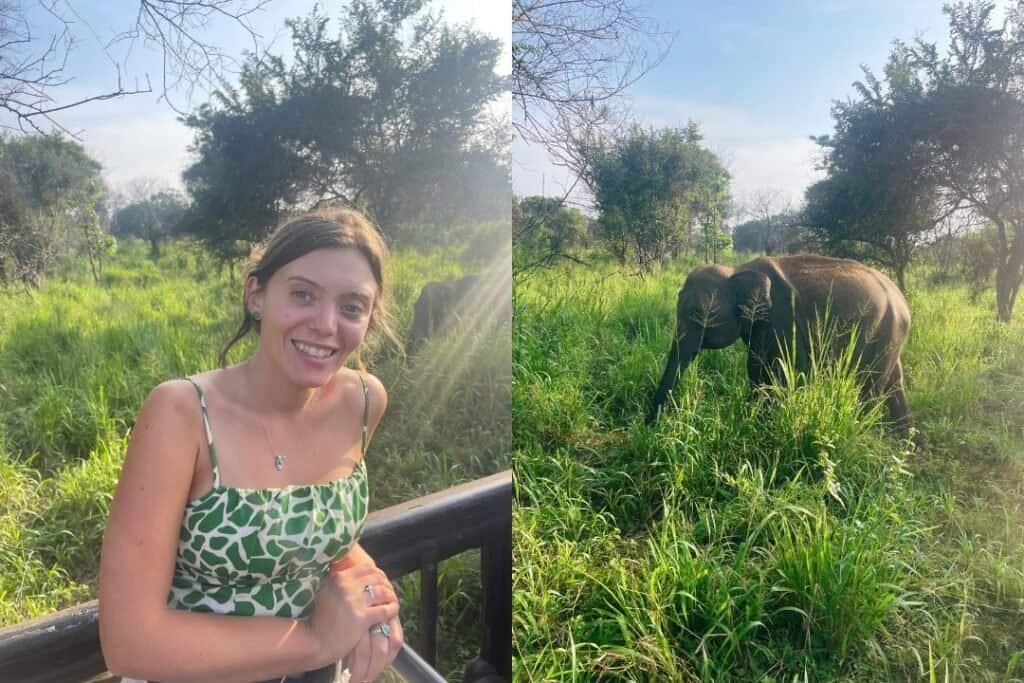
Sigiriya Rock and Pidurangula Rock
As a cheaper alternative to Sigiriya Rock (Lion’s Rock), is Pidurangula Rock. The rock is opposite Sigiriya Rock and offers similar 360-degree panoramic views for 500 rupees ($2.50 USD). Instead of the 5,000 rupee entrance fee required to hike up Lion Rock just next to it. If you go for sunrise or sunset to make it even more breathtaking, but it is very busy at sunset, so bear that in mind. The 30-minute climb to the summit is straightforward, and you do not need a guide. Though guides are available there at the entrance if you want to get more of a historical and ecological perspective of the site.
When you hire your tuk-tuk to get you the 5km north of town to Pidurangula’s base. Be sure to arrange it so that they also take you back to town when you’re done. Some people struggled to get a ride back to town and almost had to walk in the dark. The route back to Sigiriya is along a stretch of road known for its wild elephant crossings. You should be able to arrange that round-trip transport with your TukTuk beforehand.
One other warning: there are a lot of monkeys up on the rocks, and they will come for you if you have food. So keep everything in your backpack where it is hidden, or do not bring it up on the climb.
We did not climb Sigiriya Rock, but it is a UNESCO site with stairways that snake up through rock faces to frescoes, terraces, and a summit plateau with sweeping views.

Colombo — 2 nights
Colombo is a working, dynamic city that often surprises travelers with good food, shopping, and seaside walks. We didn’t stay long but visited a friend in a suburb just outside the main city; their hospitality showed us the local life of family life and food culture.
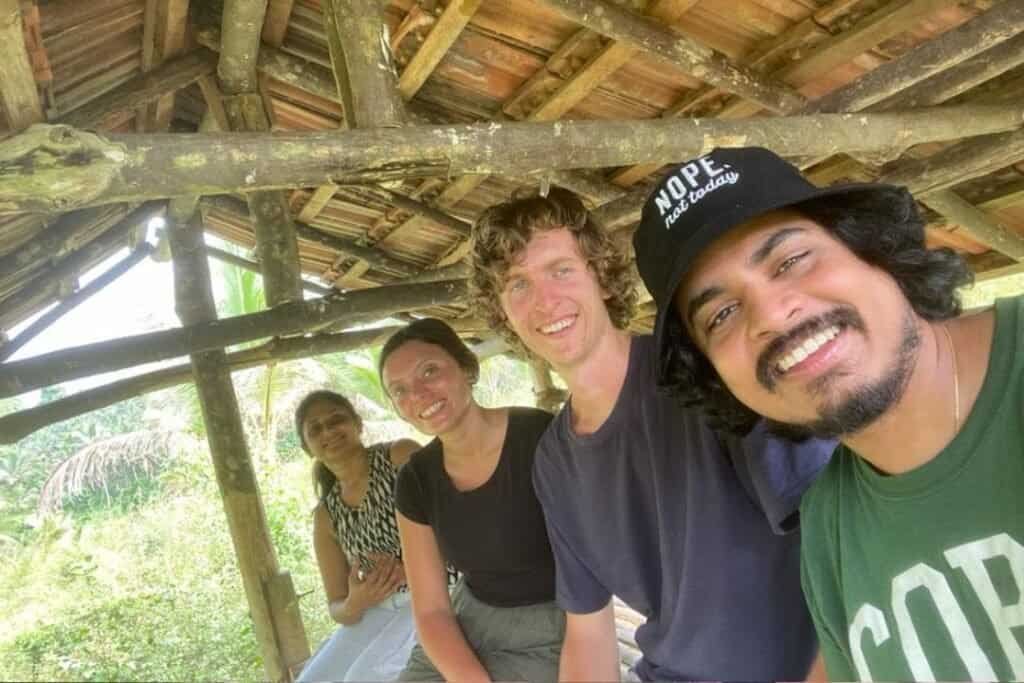
Colombo has everything: modern malls, colonial buildings, seaside promenades, and a thriving café scene. Key attractions include Galle Face Green for sunset, the Old Dutch Hospital for dining, and the National Museum if you want a primer on Sri Lanka’s recent history. For markets, Pettah Bazaar is an intense, colorful maze that’s great for bargain finds, but keep valuables secure. Colombo’s restaurants have a wide range of prices — street stalls for $1–$3 snacks, midrange restaurants $6–$15, and high-end dining that can rival prices in major world cities.
In terms of getting around, rideshare apps (PickMe, Uber in some regions) are available in Colombo and are a cheap, low-stress option for city trips. Tuk-tuks and metered taxis are frequent, but always agree on a price or request the meter. If you’re finishing or beginning your trip here, factor in a buffer for airport connections — traffic can be heavy at peak times.
Two days in Colombo are enough for a gentle look, shopping, and connecting logistics for flights. If you like nightlife or modern dining, add a night for restaurants and rooftop bars. Otherwise, it’s a practical gateway before or after your island loop.
Costs & Accommodation
Budget travelers often do well in Sri Lanka: local food stalls, buses, and simple guesthouses keep daily costs low. A budget backpacker can expect to spend about $25–$40 per day covering hostel beds, local meals, and transport via buses and occasional trains. Hostels: dorm beds typically range from $6–$12 per night in tourist towns; private rooms in budget guesthouses might be $12–$25.
Midrange travelers who want private rooms, occasional guided tours, and more comfortable transit should budget roughly $50–$100 per day. Midrange accommodation is often $40–$90 per night for boutique guesthouses and 3-star hotels. Expect guided day tours (e.g., safari, tea plantation tour) to run $30–$80 each, depending on group size and included meals.
Luxury travelers will find 4–5 star hotels and private drivers available at very reasonable prices compared to Europe. Luxury villas, upscale beach resorts, and boutique hotels range from $120–$300+ per night, depending on location and season. Private drivers for multi-day trips often cost $50–$100+ per day (fuel included sometimes) and are an option if you prefer comfort and flexibility.
Other typical costs: tuk-tuk short hop $1–$6, train 2nd/3rd class intercity $1–$10 (depending on distance and class), domestic short taxi/uber $10–$40, meals at local restaurants $2–$6, nicer sit-down dinners $10–$25. Entrance fees to major sites (Sigiriya, Temple of the Tooth, national parks) vary from around $10–$35 for foreigners; include some of these fees in your itinerary budget.
Seasons, Climate & When to Go Where
Sri Lanka’s weather is governed by two monsoons, which makes timing important. The southwest monsoon brings rain to the south and west coast and the hill country roughly from May–September, while the northeast monsoon affects the east coast mainly from October–January. That means the classic advice: visit the west/south coasts and the hill country between December and April, and head east (Arugam Bay, Trincomalee) between May and September.
January–April is our recommended window for the route above (Weligama south coast through the central hills and Cultural Triangle) — conditions are generally dry and sunny, which makes beaches pleasant and hikes accessible. April can heat up in low-lying places, so plan earlier starts and keep hydration in mind. May–September is great for East Coast surf (Arugam Bay), with quieter beaches overall and different festival seasons to enjoy.
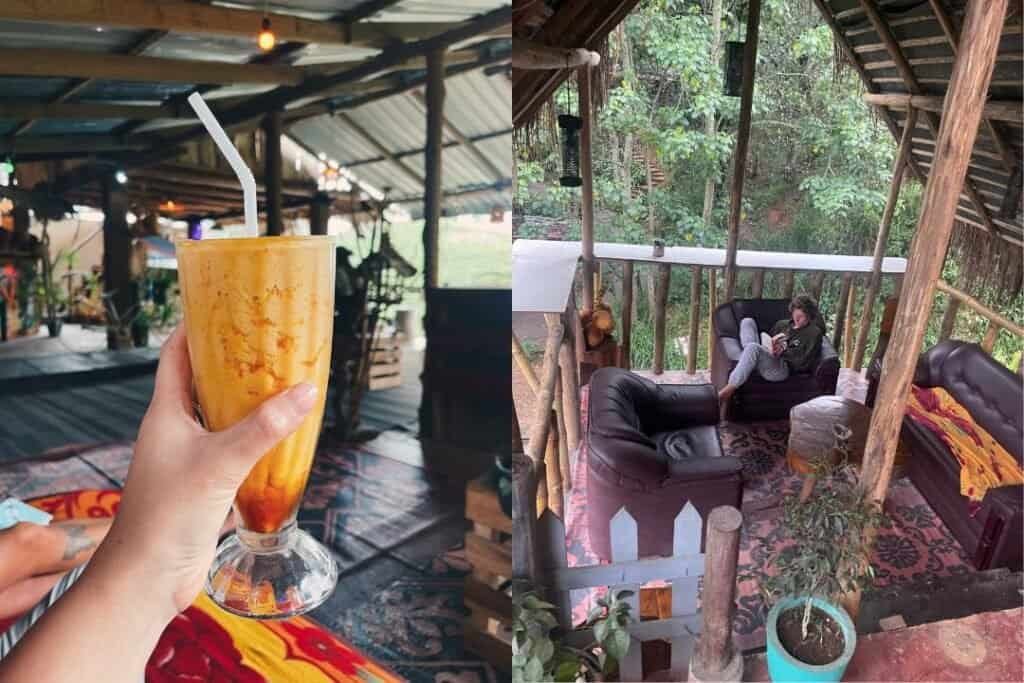
Shoulder seasons (March–April, September–November) can be excellent for fewer crowds and lower prices, but watch local forecasts — short heavy showers can appear and sometimes affect ferry or inland travel timetables. If you’re flexible and want to combine beaches with jungle and hills, plan trips regionally by season, not just by calendar month.
No matter when you go, the highlands will be cooler than the coast, and nights can be chilly in Nuwara Eliya. Bring layered clothing, a lightweight rain jacket, and sun protection for long outdoor days. If you’ll be in remote areas, pack basic meds, mosquito repellent, and a water filter for peace of mind. We always take our trusted Survival Water Filter.
Travel Tips for Women in Sri Lanka
Sri Lanka is generally very welcoming to women travelers and solo female backpackers. Local culture is conservative in many rural areas. So modest dress (covering shoulders and knees) in towns and temples is appreciated and reduces unwanted attention. In tourist beach towns, dressing down to swimwear on the beach is normal, but covering up when moving through markets or transit.
Tuk-tuks and taxis are safe and commonly used; always agree on a price or use a metered/rideshare option in cities. Solo female travelers often find homestays, popular hostels, and female-run guesthouses suitable. We love homestays as hosts can offer practical advice on local customs and generally are very helpful and care for your safety. Late nights in big cities are manageable if you use trusted transport (reliable rideshare or arranged hotel pickups).
Keep a small scarf or sarong handy for quick temple visits and to make outfits more versatile. For safety, carry copies of important documents, a local SIM or roaming data, and a small flashlight for late arrivals. Be cautious about sharing too many details publicly — like exact accommodation for upcoming nights — and rely on local hotel/host contacts for trusted transport and activity bookings.
Transport: Trains, Buses, Tuk-tuks & Rideshares
Trains in Sri Lanka are cheap, scenic, and often the highlight of a trip — especially the Kandy-to-Ella stretch. Book early for reserved seats in 2nd class or observation car options during high season; unreserved 3rd class is an affordable alternative, but busy. Expect long journeys to be slower than their map distance suggests; allow extra time for delays and for the experience.
Buses are the cheapest nationwide option and have extensive networks. Long-distance A/C coaches run between major cities for $5–$15 depending on distance; local buses are cheaper but crowded. For comfort and time savings, midrange travelers opt for private hires or tourist coaches for longer hops.
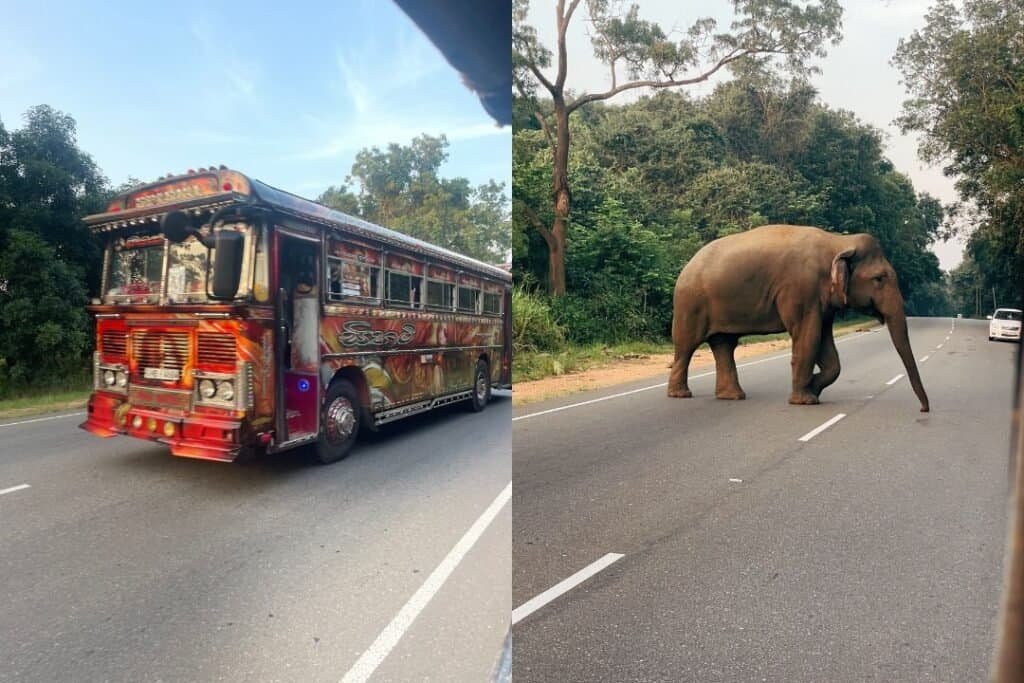
Tuk-tuks are the workhorses for short distances. Negotiate fixed fares for longer trips or insist the meter is used in cities. For multi-day routes, private drivers offer convenience and comfort — expect to pay $50–$90 per day, including fuel (negotiate what’s included). Rideshare apps like PickMe and Uber operate in Colombo and some towns and are often a better value and safer option late at night.
There are domestic flights available between some hubs, but they are usually unnecessary for a two-week loop unless you’re short on time. Night buses exist, but they vary in comfort; we prefer daytime travel and staying overnight rather than arriving tired late at night in Sri Lanka. For luggage and comfort on winding roads, consider upgrading to private transfers for long intercity hops if your budget allows.
Currency and Practical Advice for Sri Lanka
Currency is Sri Lankan rupees (LKR); ATMs are common in cities and tourist towns but can run dry in remote areas. Carry some cash for small shops, markets, and tuk-tuks. Credit cards are common in midrange and luxury hotels and many restaurants, but not everywhere, so always have a small cash stash.
Water and food: Stick to bottled water for drinking and be cautious with raw salads in street stalls if you have a sensitive stomach. Fresh fruit, cooked street food, and rice-and-curry from busy stalls are usually safe; carry oral rehydration salts if you get travel sick. If you want to be extra cautious, eat where locals queue — high turnover is a good sign.
Connectivity: local SIM cards (Dialog, Mobitel) are cheap and give good coverage in towns; buy at the airport or from city kiosks. Internet speeds vary — faster in cities and coastal tourist towns, patchier in hill country or jungle areas. Download offline maps and keep copies of reservations handy.
Respect: Sri Lanka has strong cultural customs. Remove shoes when entering temples, dress modestly, and avoid public displays of affection. When visiting religious sites, follow signs and local guidance. Tipping is appreciated in restaurants and for guides — 5–10% is typical in midrange spots.
What to Pack for Two Weeks in Sri Lanka
This is very similar to our India packing list guide. Both are conservative countries, but you can wear sleeveless tops and shorts in Sri Lanka, as it is more relaxed.
A practical, travel-light kit: a lightweight rain jacket, layers for hill nights, a sarong/scarf for temples, decent walking shoes, a water bottle, mosquito repellent, basic first aid, a power bank, a universal adapter, and a compact flashlight.
For surfing: bring reef-safe sunscreen and quick-dry swimwear; for hiking, a small daypack works best.
Sri Lanka is an easy-to-love country that rewards curiosity: the food is generous, the train journeys are memorable, and the mix of beaches, hills, and cultural history makes for a rich two-week loop. With a modest budget, you can travel comfortably; with more spending, you can move faster and sleep better. Either way, try to leave space in your itinerary for slow mornings, local conversations, and moments of quiet on a tea slope or shoreline.
Daily Budget Breakdown for Sri Lanka
Backpacker Budget Breakdown for Sri Lanka (Approx. $25–$40 USD per day)
- Accommodation: Dorm beds or local guesthouses from $6–$15 per night.
- Food: Street meals or local restaurants $2–$6; fruit smoothies or western cafés $5–$10.
- Transport: Local buses $0.50–$2 per ride; trains $1–$5; occasional tuk-tuk $2–$6.
- Activities: Hiking and free attractions mostly cost nothing; entrance fees (Sigiriya, temples, safaris) $10–$35.
- Extras: SIM card with data $5–$10, daily coffee/snack budget $3–$5.
Expect to spend around $30 per day on average if you eat local, travel overland, and share rooms or dorms. Add $10–$20 extra per day if you take frequent taxis or guided tours.
Mid-Range Traveler Budget (Approx. $60–$100 USD per day)
- Accommodation: Boutique guesthouses or private double rooms $40–$80 per night.
- Food: Mix of local and western cafés $10–$25 daily; nicer restaurants $20–$30 for two people.
- Transport: Reserved train seats or private transfers $10–$40 depending on distance.
- Activities: Paid cultural sites and day tours $25–$60 each.
- Extras: Occasional massage, coffee shop workdays, or souvenir shopping $10–$15.
Mid-range travelers spend $75 per day, enough for comfortable transport, private accommodation, and upmarket meals. If you add safaris or guided hikes, plan for $90–$100 per day occasionally.
Sri Lanka is an easy-to-love country that rewards curiosity: the food is generous, the train journeys are memorable, and the mix of beaches, hills, and cultural history makes for a rich two-week loop. With a modest budget, you can travel comfortably; with more spending, you can move faster and sleep better. Either way, try to leave space in your itinerary for slow mornings, local conversations, and moments of quiet on a tea slope or shoreline.
Enjoyed our guide? Read more
10 Best Spiritual Retreats in India 2025
The Barefoot Backpackers’ India Travel Guide
The Ultimate India Packing List for Women








